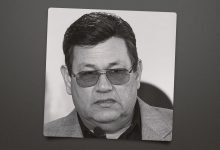Wes Anderson Shares How Indian Cinema Legend Satyajit Ray Shaped His Aesthetic

When Satyajit Ray’s 1970 film Aranyer Din Ratri (Days and Nights in the Forest) returned to Cannes this May, it was far from a faded relic. Restored by Shivendra Singh Dungarpur and the Film Heritage Foundation, the film, in ravishingly revived form, was selected for the prestigious Cannes Classics section as a testament to Ray’s enduring influence on world cinema through classics like 1955’s Panther Panchali, which is the first film in the director’s celebrated Apu Trilogy.
To mark the occasion, The Hollywood Reporter India spoke with three individuals deeply touched by the film and its creator: legendary Indian actress Sharmila Tagore, a frequent Ray collaborator; Wes Anderson, whose work bears Ray’s influence; and Dungarpur, whose archival work revived the film.
“I watched [Ray’s 1961 title] Teen Kanya first, just because it happened to be available in a video store in Texas,” Anderson recalls. “That’s how I became interested in his films. I saw images from Ray’s work and thought, ‘That’s the way I want to be.’”
But Days and Nights in the Forest was elusive for years. “It was virtually unavailable, and the copy I saw was a poor one with a translation done by someone who probably didn’t speak Bengali or English,” Anderson says, laughing. “But I loved it. It reached me anyway.”
The film, a philosophical meditation on masculinity and disconnection, also marked a turning point for Ray’s creative methods. “He had complete control over his craft. I’ve never seen a more hardworking director,” Tagore says. “In Days and Nights in the Forest, [cinematographer and frequent Ray collaborator] Subrata [Mitra] wasn’t there, so he was also operating the camera himself. From that film onwards, he practically went solo.”
Adds Tagore: “We’d get handwritten scripts, and we weren’t encouraged to memorize them. [We] could improvise, but Soumitra Chatterjee was not allowed to move even slightly away from what was prescribed,” she says, explaining Ray’s meticulous methods and his preferred directing style for his regular leading man.
Yet Ray’s warmth remained evident. “He was never imposing,” Tagore recalls. “He was also very good with kids on set.” Anderson agrees: “You can feel his gentleness come through in every frame.”
Dungarpur recalls long hours spent restoring the film, reflecting on Ray’s meticulous attention to detail and how every frame was carefully storyboarded. “Ray lives in these details, and it’s in those details that you can find him again.”
The Hollywood Reporter India’s full Cannes conversation with the trio of Ray devotees is below.
Shivendra, for the fourth year in a row, the Film Heritage Foundation has a film in Cannes Classics. This year, you have two films.
SHIVENDRA SINGH DUNGARPUR One of the big things for the foundation now is to support films not just in India, but across the world, especially those films that people find difficult to see.
Aranyer Din Ratri is not just my creation. It’s the creation of the Criterion Collection, the Film Heritage Foundation, because they put the force behind it. I was just the one doing the restoration.
The restored film begins with a special thanks to Wes Anderson. Wes, you’ve spoken about the influence that Satyajit Ray had on you.
WES ANDERSON The first Ray film I saw was Teen Kanya, when I was probably 18 years old. I watched this film knowing nothing about who that is, or even how to say the name. I was very taken with these stories and these actors. In the course of time, I saw Pather Panchali and the Apu films, which have now been restored for quite a long time. Back then, the copies were bad.
But I got to know, through the films, a filmmaker who I felt worked in the most independent way, a most intelligent kind of writer. I also saw images of Ray, and I thought, that’s what I want to be like, if I can be like that.
Sharmila, there’s a scene in Aranyer Din Ratri where your character is speaking about the death of her mother and brother, and the camera is just on your face. You see the tears, but they don’t fall. What do you remember about shooting that?
SHARMILA TAGORE [Satyajit] never over-instructed. All of us got his handwritten, bound scripts that we were supposed to read, but we were not encouraged to memorize any of the dialogues. So when this particular scene was happening, I was told not to prepare for it. And then he just came very close to me and narrated it in a way that I could visualize it. I cannot explain the chemistry, or how he managed to get through to me, but he did.
Could you create dialogue? Was he okay with that?
TAGORE When we were playing the memory game [a revealing game the characters in the film play], Rabi Ghosh could improvise. But with Soumitra Chatterjee, he wouldn’t let him move his hand from here to there. Even in Shatranj Ke Khilari, the Hindi film that [Ray] did, Sanjeev Kumar told me later that if he had moved his elbow from here to here, he would object. So, I think his framing was very important. He had complete control over his craft.
In Days and Nights in the Forest, his director of photography Subrata Mitra wasn’t there. He was operating the camera himself. From Aranyer Din Ratri, he went solo.
ANDERSON I think he did even the titles.
TAGORE He was in advertising, so he had that talent. Every aspect, even the set [design] — what art directors do — even that was his. In Hirak Rajar Deshe, he did the costumes as well. I can’t think of any other director who covered all aspects.
ANDERSON When you decide you’re going to make a film and you have never done it, you have to be some kind of impresario in a way to force the thing to happen, to get the people together and do it.
TAGORE But so gently. You never felt the pressure that he’s directing you or he’s confining you. He would come very close — he was a tall man, right? He would bend a little bit and whisper in your ear what he wanted done so that nobody could hear, especially when he was working with a child. But he was not imposing. We never felt the pressure of working with Satyajit Ray.
ANDERSON Yes, you feel gentleness in his films. That comes through. But his physicality is quite imposing.
TAGORE And the voice, yes.
You recreated the memory game in Asteroid City.
ANDERSON Yes, well, stole it. The concept of the scene is very odd because it’s a game. But we learn about these characters so much while they play these games. And then the way it’s photographed — the cast is obviously a special cast — but the way it’s photographed is very striking.
This is a scene that I love. In fact, my family and I began to play this game. After I first saw the movie, I started sharing this game, because you learn about each other.
Shivendra, you said that every restoration has its own challenges, right? What were the specific ones in this film?
DUNGARPUR When we started the process, it was during Covid. I remember I had to take a flight to go and see this negative. In India, because most of these films are shot on acetate, it’s very hard to find the original camera negative. I went all the way to [Kolkata]. I found the film in one of the storerooms. And it was the original camera negative. I couldn’t believe it. So, when you find the original camera negative, you want to begin. I was excited that I wanted to do it. And then, of course, thanks to Margaret [Bodde] of the Film Foundation, Pia Becker and Filmico, we started working on it.
It took us a while. Most of the restoration was done in Bologna. But the challenge was the color grading. Because how do you grade a Satyajit Ray film? I kept Subrata Mitra’s work in mind and the work we did in the early films, especially the Apu trilogy.
ANDERSON But you have no other reference. You have to make those choices.
DUNGARPUR So, I was making that reference. Because even [his son, Sandip Ray,] said, “I was not on that shoot. I don’t know.” Also, the subtitling — it was not easy, because we were trying to locate the original subtitles. We couldn’t find the original. So, we got one of Indrani Majumdar’s, who was the only person he trusted with his work. It was an amazing experience.
What is so lovely about [doing this] work is that you get to see the film shot by shot. You’re going back and forth and you continue to learn and learn. I think that’s so lovely about restoration.
TAGORE I remember seeing [1960’s] Devi before it was restored. The first scene of the visarjan, nothing was sparkling. It was all dead. The audio wasn’t clear. And then when you saw the restored version… So really, thank you.
ANDERSON I do remember getting the email from Margaret when you had found those cans of green plastic cases. I still have that email. At that moment, I thought, it’s really going to happen, because I’d been asking about it for some time.
DUNGARPUR It was to just get clearances. In India, it’s not easy to get through to people. Because when you say you want to restore, they think you want to make lots of money. They don’t realize that we have to be realistic. And also, restoration is all about not doing too much. You cannot alter it. You’ve got to envision what Ray would have thought all the time. And I had that vision. I used to keep that storyboard. I used to keep his notes. I wanted to take a decision as somebody who’s just helping [recreate the film] how Ray would have loved to see it.
ANDERSON [To Tagore] What was the dynamic with him?
TAGORE I worked with him when I was 13 in The World of Apu. He introduced me to film, so I always treated him with a little bit of awe, a little bit of respect, like we give to our fathers. So, I never really became a pal. It was such a wonderful outdoor [shoot]. But you just cannot imagine how hot it was.
He wanted that time because the trees were leafless. Skeletal trees. He wanted a particular look, only possible in that month. Because then the rains came soon after.
Can I end with a question to you, Wes? After Asteroid City, film critic Richard Brody said this about you in The New Yorker: “He doesn’t create and direct a scene for any outer dramatic necessity, but under the intense inner urgency of what it means to him personally. Every dot of paint and detail of hairstyling is invested with the fervour of his own emotional memory. He himself, not his cast, is the supreme method actor of his own films.” Does this ring true to you?
ANDERSON I love the idea of being seen that way. I sort of relate to what he describes a bit, too. But I would feel uncomfortable saying more than that.
Source: Hollywoodreporter
HiCelebNews online magazine publishes interesting content every day in the movies section of the entertainment category. Follow us to read the latest news.
Related Posts
- Sophia Bush Alleges She Received “Every Kind of Abuse” on a Certain TV Show
- Ike Barinholtz Jokes He’s “Lucky to Be Alive” After Driving WIth ‘The Studio’ Costar Seth Rogen
- Inaugural Pride LIVE! Hollywood Fest Expands Lineup With Music Events, Screenings and More
- Locarno Unveils Open Doors Program Projects, Producers for First Edition of Africa Focus
- Savannah Guthrie Recalls Leaving Her Delivery Room ‘Trashed,’ Chilling Wine in the Hospital Urinal





